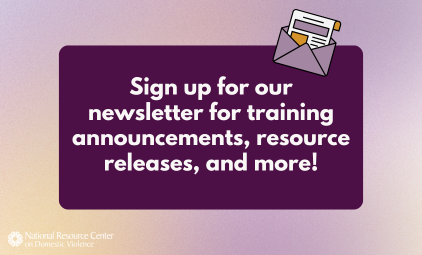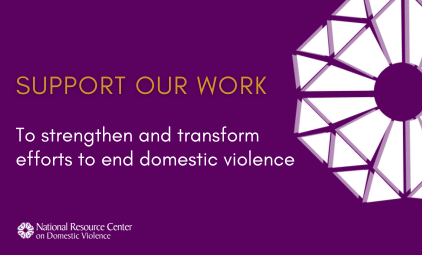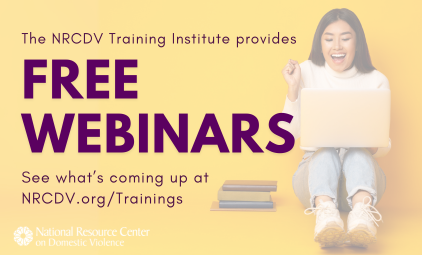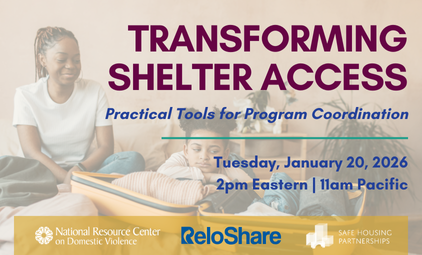By Darin J. Dorsey, Principal/Founder of Rooting Movements
The work of domestic and sexual violence organizations requires the coordination of many roles —staff, board members, survivors, community and system partners, funders, and more. Our work is built on relationships and collaboration, and it takes all of us working together to support survivors and prevent violence. Because our work is complex, it’s important to manage these relationships in a way that keeps us focused on our shared mission: empowering survivors and ending violence. Collaborative and transparent decision-making processes can help us build stronger connections both inside and outside our organizations.
This TAQ offers guidance on how organizations can create decision-making processes that stay true to their mission while strengthening relationships with stakeholders (i.e., anyone involved or affected by the decision). We’ll talk about how to keep moving forward while maintaining trust, even when people don’t fully agree. We’ll also go over practical ways to include stakeholders in different situations. We’ll wrap up by emphasizing how thoughtful, collective decision-making can strengthen our movement to end domestic and sexual violence.
Mission-Aligned Decisions
An organization’s mission should be the foundation for how decisions are made. When decisions are based on other reasons—like convenience, pressure, or assumptions—it can lead to confusion, conflict, or even harm. A mission-aligned decision doesn’t always show an immediate impact, and that’s okay. It’s about looking at both the short-term and long-term effects.
For example, cutting back on service hours might seem like it limits how much support survivors can get right away. But it could also give staff more breathing room, which might help reduce burnout, improve the quality of support, and create a healthier, more sustainable work environment—especially when staff are also survivors.
It’s also important to remember that stakeholder roles aren’t fixed. People wear many hats. Staff may be survivors. Board members may be community members. Survivors may be partners or funders. These roles can shift and overlap over time.
Even though a mission statement may look simple on paper, it’s often open to interpretation. That’s why it’s important for domestic and sexual violence organizations to regularly revisit their mission and talk about what it really means. This helps build a shared understanding that can guide decisions in complex situations. These conversations should happen not only within individual organizations, but also across partnerships and networks—because this work is deeply interconnected.
Share-First Approach
Being transparent is a key part of making decisions that strengthen relationships. Ideally, we want to involve people in decisions that affect them. But sometimes, due to time or capacity, that’s not always possible. When that happens, simply sharing information can still go a long way in keeping people connected and engaged.
Organizations often default to keeping information close, but that can create confusion and mistrust. At Rooting Movements, when we work with organizations to improve workplace culture and well-being, we often talk about the difference between two approaches: need-to-know and share-first.
A need-to-know approach means only sharing information when it’s absolutely necessary. A share-first approach means sharing information by default—unless there’s a clear reason not to.
Using a share-first mindset turns decision-making into an opportunity for connection. Even when people don’t agree with a decision, they’re more likely to understand and accept it if they’ve been kept in the loop. When stakeholders are left out, we risk creating misunderstandings or conflict—and we lose a chance to build trust.
A lack of transparency is often a sign of paternalism—when decisions are made for people instead of with them. Sometimes, leaders or managers choose not to share information because they’re worried about how others might react. For example, they might keep quiet about funding challenges to try to avoid causing stress or fear.
While it’s important to be thoughtful about how we communicate tough news, it’s not our job to manage other people’s emotions by keeping them in the dark. Trying to control reactions by withholding information can actually create more harm in the long run.
Stakeholder Involvement
In this section, we’ll look at ways to include stakeholders in the decision-making process through 1) sharing information, 2) asking for feedback, and 3) making decisions together when possible.
How we make decisions will depend on the situation. Sometimes, we’re short on time and can’t involve everyone. Other times, a decision might not align with what some stakeholders want. And in some cases, we may not be the right people to make the decision alone.
The first step in involving stakeholders is figuring out what kind of engagement makes sense. A helpful way to think about it is in three levels:
- Sharing Information
- Seeking Feedback
- Collaborative Decision-Making
Which level you choose will depend on your relationships, how big the impact of the decision is, and how much time and capacity you have. And, as always, your mission should help guide how you engage others in decision-making.
1. Sharing Information: Keeping people informed builds trust and helps prevent confusion or division. You might do this by sending a newsletter, giving updates during community or staff meetings, or using email to share changes. Even when stakeholders can’t be involved directly, sharing information keeps the door open and strengthens connection.
2. Seeking Feedback: Getting input shows people their perspectives matter and helps you make more informed decisions. It also allows for broad engagement without slowing things down too much. Feedback can be gathered through surveys, group discussions, or one-on-one conversations. This approach is especially useful when the decision affects many people, but collaboration isn’t possible or practical.
3. Collaborative Decision-Making: Sometimes the best decisions are made together. It’s important to recognize when your organization might not be in the best position to make a decision on its own. In those cases, it helps to identify who is best suited and involve them directly. That could even mean stepping back and letting others take the lead.
For example, frontline staff may have the clearest insight into how a change will affect clients, while others may better understand the budget or big-picture impacts. Collaborative decision-making brings these perspectives together to make stronger, more thoughtful choices.
There’s no one-size-fits-all way to collaborate. Different situations call for different strategies. If we want decision-making to build connections, we need to pay attention to power dynamics—especially when people with less power are part of the conversation. In these cases, bringing in a neutral facilitator can help ensure the process is fair and inclusive.
Key Takeaways
- Align decisions with the organization’s mission to avoid confusion and conflict.
- Use a share-first approach to build trust and reduce misunderstandings.
- Involve stakeholders by sharing information, seeking feedback, and collaborating on decisions.
- Adapt engagement based on the situation, considering time, impact, and relationships.
- Be mindful of power dynamics and use neutral facilitators when necessary.
Collective, transparent decision-making strengthens the movement and builds resilience.
Conclusion
At the heart of this work is the understanding that we’re stronger when we move together. Building connection through intentional, transparent decision-making isn’t just about keeping people informed—it’s about creating a shared sense of purpose, deepening trust, and making space for a range of voices and experiences. When we align our choices with our mission and values, we help shape a more coordinated, thoughtful approach to ending domestic and sexual violence. This kind of collective strategy builds resilience—not only in our organizations, but across the broader movement—so we can continue to adapt, grow, and support each other through challenges and change.














